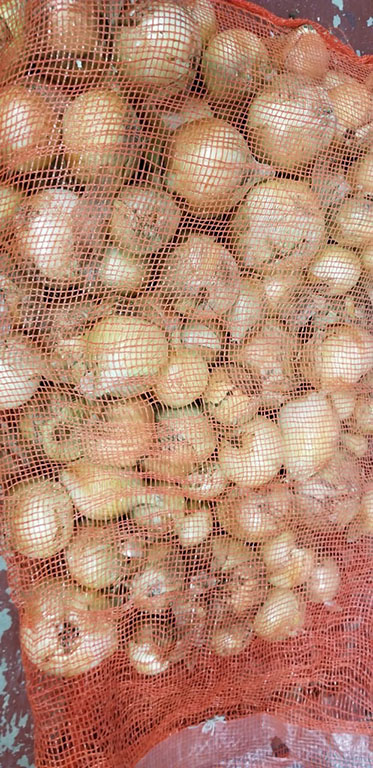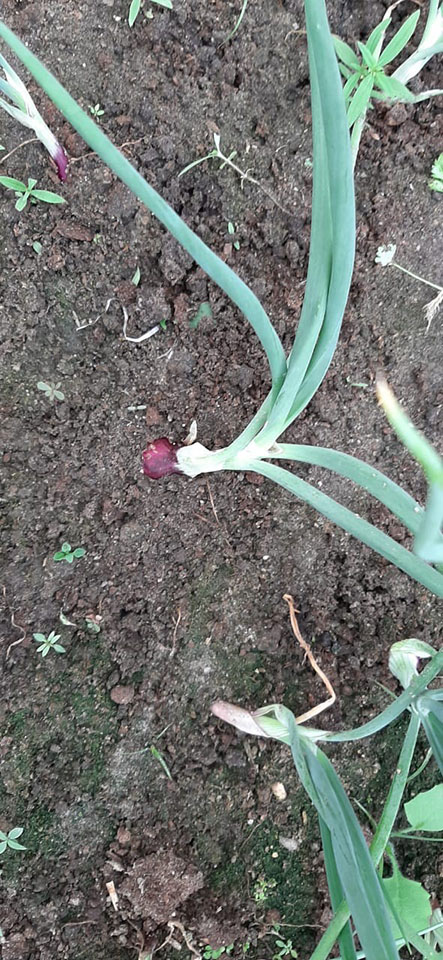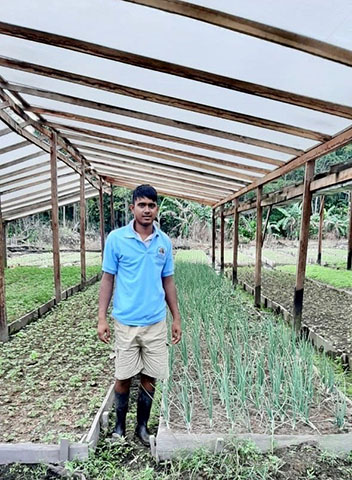A Timehri, East Bank Demerara cash crop farmer who willingly agreed to try onion farming when the National Agricultural Research & Extension Institute (NAREI) approached him, is happy that the crop is “coming ‘A’ one.”
Haimchan ‘Vicky’ Segolam, 25, told Stabroek News (SN) that although the crop is only halfway ready for harvesting, which he is eagerly looking forward to, and requires little attention he is seeing “good results.”
He applied fertilizer twice; once in the beginning, another at 21 days and has to wait until it is 42 days to apply the final dose. He also monitors the crop for insects and cleans off the weeds.

At one time he noticed that the tip of the plant was getting brown but he was able to deal with it using a chemical that NAREI provided. He was pleased that not too many of the plants have died. He also noted that, “It looks as if it is capable of resisting the heat and cold.”
He promised that if the crop is successful and “the market take it off nicely to compensate me I will continue with it. He plans to supply to a prominent supermarket. He is also excited about trying other produce through NAREI, including potato and carrot cultivation.
He currently has 3000 onion plants under cultivation on two beds. On one of the beds he practices shaded cultivation while the other bed is in open field. He has noticed that the bed under the shade is “growing better.”
Segolam was originally farming lettuce, parsley and celery in large quantities. He supplies his produce to Bourda and Stabroek markets and to some small restaurants.

During the last rainy season which extended into August, he suffered a lot of losses with his crop. He had actually gone to NAREI to purchase the garden plastic to provide shade for the plants when he was told of the onion venture.
The soil he uses is pagasse (made up of organic decomposed vegetation) mixed with black sand and he is happy with the results so far.
Segolam is one of 25 farmers around the country that are currently involved in the onion cultivation through the NAREI programme, which is intended to reduce the importation of the commodity.
The onion programme, along with potatoes was implemented through the non-profit organization, World University Service of Canada and the Canadian-funded Promotion of Regional Opportunities for Produce through Enterprises and Linkages (PROPEL).
The organizations have provided support through the establishment of Farmer Field Schools and supplying seedlings to farmers, with funding to the tune of CAN$100 million, compliments of the Canadian Government.
Dr. Oudho Homenauth, Chief Executive Officer (CEO) of NAREI told SN that the other farmers are from Laluni and Bamia in Linden.
A farmer from Parika Backdam, Vernon Fraser joined the team during last week with the cultivation of 50,000 seedlings. Farmers in regions five and six were also part of the programme and had seen successful yields.
Dr. Homenauth had told this newspaper that data from the Bureau of Statistics proved that US$1.459 M was spent to import 3.987 million kilogrammes of onions in 2015, as compared to US$1.585 M to purchase 4.016 million kilogrammes in 2014.

Now, based on the current yields, NAREI projected that it would need to produce 235 acres of onions to reduce the importation. They are still in the “biting stage” and are looking for more farmers who are “diligent and willing to take care of the crop.”
The price for imported onions currently starts at $100 per pound and it was observed that most of them are of poor quality and would spoil easily. In the case of the locally produced onions, they have a shelf life of 100 days, unrefrigerated.
Dr. Homenauth told SN that they started with seven varieties but decided to “stick with the ones that are suitable for our tropics.”
They are the Mercedes, Texas Early Grano, Yellow F1 Granex and the Red Creole or the purple onions that are used for salads and have a higher value in the market.
Research scientists, David Fredericks and Tracy Persaud, who were also present during the interview, conduct initial visits to the farms to ensure that the conditions are suitable for cultivation. Along with the onion seeds, they provide the farmers with the expertise they need to harvest a successful crop.
Soil analysis
They start with a soil analysis, advising that it should be “sandy or loamy” and “do not encourage the use of too much heavy soil or clay, which can hamper the crop.
After selecting a site for the cultivation, they advise on land preparation and would return to “ensure the land is properly tilled before putting down the seeds.”
According to the research scientists, transplanting is only done for small farmers while direct planting is done for farmers with larger acreage.
The said that the “cost for production is very low and it [onions] require a very small space to grow. “The maintenance in terms of pests and diseases is very low as the onion exudes a kind of anti-pesticidal properties to keep pests away,” Fredericks said.
In terms of training, they would “use the farmers who have success stories to provide the information to the other farmers” through a field school.
Dr. Homenauth said that they tried out the crop in 2017 with different farmers and in 2018, they “ramped up the production, where they got more people involved for them to see the financial benefits.”
There has been a great demand for the local onion and the majority of it was retailed “at the farm gate” with only a small amount reaching the supermarkets, that branded it ‘grown in Guyana.’
In 2018, a farmer from Philippi on the Corentyne reaped over 200 pounds of onions and sold it at $100 per pound, while the imported onion was selling at $80.
The researchers also encourage farmers to have raised beds, using stilts or flat raised beds so as to avoid the effects of the adverse weather conditions. One of the advantages of having raised bed gardens is that they do not get waterlogged easily.
The open bed onion farming takes about 120 days. This is suitable for the Texas Early Grano variety, which requires direct sunlight. Harvesting for the Mercedes variety, which requires shade takes about 150 days after cultivation.
They noted too that onions cannot tolerate much water just before harvesting as it would cause the bulbs to rot. If there are heavy showers close to harvesting, they advised farmers to provide plastic shade for the plants.
According to Dr. Homenauth, reducing the importation of onions would also benefit the farmers financially. He is confident that soon more farmers would want to be a part of this venture.





